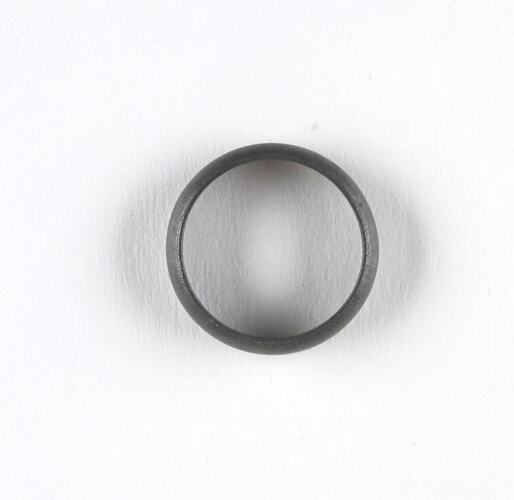Summary
Metal wedding ring belonging to Dina Thieberger (nee Goldnerkreuz) who migrated to Australia in 1950. The ring, which had originally belonged to her mother, was issued by Mussolini's fascist government to many Italian women who responded to a call for gold and gave up their wedding rings and other gold jewellery in the interests of the state's war effort. These women received Italian-made 'replacement' rings with the inscription 'Oro alla patria' (gold for country) and a date. Italian women who already resided in Australia also responded to this demand and sent their rings to the Italian Consulate-General in Melbourne. This ring was probably given to Dina by her mother when she left for Australia or during subsequent visits.
Dina, whose family Italianised the family name to 'Crocedoro' during World War II, was born in 1929 and grew up with her parents and two older sisters in Gorizia in the Friuli-Venezia region in the north of Italy, now on the Slovenian border. Her father was a postmaster, her mother from a peasant family. Dina met Henry Thieberger, a Polish Jewish man, on a train to Austria around 1948 when he was on his way to migrate to Australia. He had been deported to Siberia during the War. Dina followed in 1950, travelling on the 'Ugolino Vivaldi' (at that time chartered by the Lloyd Triestino Line from the Italia Line) and they married in Melbourne. Henry came with his parents and sister, sponsored by an uncle already in Australia.
Physical Description
Dull grey metal ring, plain band. Inscribed on the inside of the ring.
Significance
This ring provides an important material context for the impacts of World War II on the women of one country, many of whom subsequently migrated to Australia. It provides an enduring symbol of the Mussolini fascist regime, the nationalistic demands made on his people and the consequent devastation that contributed to the migration of thousands of Italian people to countries including Australia after the War. There are also transnational connections with these rings both being brought by migrating women to Australia; and also such rings being sent across the world to Italian women already in Australia who gave up their own gold rings. There is a poignancy in the image of women sacrificing a very precious and personal possession, tempered by the reality of the brutal cause to which they were contributing.
More Information
-
Collecting Areas
-
Acquisition Information
Donation from Mr Nick Thieberger, 31 May 2011
-
Place & Date Issued
Italy, 1935
Issued to Dina Thieberger's mother after she responded to the call for gold by Mussolini's fascist government, and gave up her wedding ring and other gold jewellery in the interests of the state's war effort. -
User
Mrs Dina Thieberger, Melbourne, Victoria, Australia, 1950-2000
-
Inscriptions
ORO ALLA PATRIA-18-11-35-XIV
-
Classification
-
Category
-
Discipline
-
Type of item
-
Object Dimensions
20 mm (Width), 5 mm (Height), 20 mm (Outside Diameter)
-
References
Ugolino Vivaldi: Peter Plowman Australian Migrant Ships 1946-1977 Rosenberg Publishing 2006
-
Keywords
Italian Communities, Italian Immigration, Wars & Conflicts, Weddings
